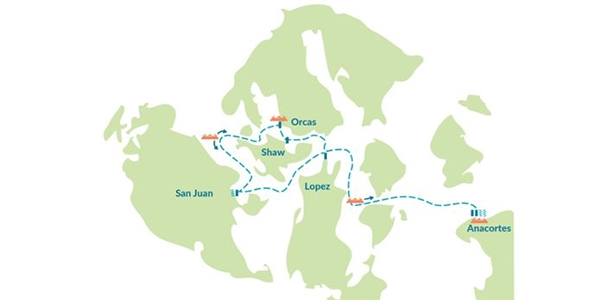— by Matthew Gilbert, Orcas Issues reporter —
On September 25, more than 150 people attended the second workshop on vacation rentals organized by the Orcas Island Vacation Rental Work Group. It was a strong show of continuing interest after July’s initial “conversation” which attracted more than 200. The format was similar but the topic areas were narrowed to focus on existing data and how to more clearly identify and address the various issues that VRs have raised – not just on Orcas but county-wide.
Yonatan Aldort began by summarizing the pros and cons of VRs that emerged from the first meeting. The pros: a boost for the economy, an expanded tax base, and owner income. The cons: cannibalization of affordable housing, the loss of rural character, and stresses on infrastructure. He emphasized that the process was still about gathering information “with a focus on unity, not division,” but the ultimate objective is an actionable response. He also reported that the VR Working Group now has a mission statement and “guiding values” that can be viewed on the website (www.vacationrentalsorcas.org), where workshop presentations will be posted as available.
Erika Shook, director of the Department of Community Development, then spoke on how the VR situation has evolved since regulations were first put into place in 1997. Summarizing much of what is generally known about the current environment (e.g., 1,040 existing legal permits, approximately 50 new permits issued annually until a few years ago when the numbers started climbing to its current 65 – 70), she said that VRs are now part of the Comprehensive Plan (CP). “We are starting to look at what may be too many and where they are located. There is currently no cap on the number of permits we can issue. This is a long-term planning issue.”
As for a question on why bed-and-breakfasts are denied permits in areas were VRs have been approved, she said this was an old regulation during a time when B&Bs were essentially the only disruptor in town. She also explained that enforcement monies for code violations ($100k in 2018) go into the general fund, and that “there is no incentive to seek fines for department operating capital!”
Lynette Wood, a retired Orcas resident with a professional background in mathematics and research, then discussed the impacts of VRs on local housing availability. She began with a quick review of housing affordability in the county relative to the rest of the state, and it was no surprise that San Juan occupies a uniquely out-of-whack situation. She followed that with a chart showing the assessed value of the 1,000+ VRs in the county. Based on the available data, she estimated that nearly 40% of all VRs were assessed at less than $400k, while a quarter have values of more than $1M. Between 2000 and 2010, there were 5.5 new dwelling units created for every new VR permit. Since 2011, that ratio has dropped to 2.2:1. According to her figures, nearly 16% of all residential housing units on Orcas are VRs (compared to 8 – 10% in the rest of the county).
“The growing prevalence of VRs is taking homes out of an already stressed housing market,” she concluded, adding that the Comp Plan’s “projected” number of VRs by 2036 will be reached in 2024 if current trends continue.
Paul Kamin, general manager of the Eastsound Water Users Association, then dispelled the notion that VRs have minimal impact on water use. Comparing VRs in the Eastsound Water service area to single family homes (again based on available data, which he readily admitted still has gaps), he reported (“Thank you, metering”) that VRs use 45% more water on a year-round basis and, more importantly, 89% more water during the peak months of July and August. He finished with a question: “Why are VR properties allowed to have more guests than the septic system is permitted to support?”
The first part of the workshop concluded with a presentation by local architect Greg Oakson who discussed the emerging notion of “overtourism,” recently defined by the World Tourism Organization as “the impact of tourism on a destination, or parts thereof, that excessively influences perceived quality of life of citizens and/or quality of visitor experiences in a negative way.” As experienced in San Juan County, he cited the following:
- Record ferry use this last summer.
- Pressure on local medical services (300 – 400 emergency calls per year historically that now exceeds 1,000).
- Expansion of the waste stream.
- Drops in reservations for existing home-grown commercial enterprises (VRs are considered residential, not commercial use).
- Septic overload.
He finished by saying that while data is good, it’s those neighborhood intangibles such as rural character and a sense of community that carry equal weight. “Once it’s gone, it won’t come back. How do we achieve the right balance?”
The next part of the meeting was small-group discussion as a prelude to voting on a series of proposed regulations/actions. If it seems to some that the meeting was dominated by pitchfork-wielding socialists, I can report that in my own circle there were two VR owners, both part-time Orcas Island residents who did not live in their rentals, who seemed genuinely concerned with what the growth in VRs might be doing to the island. Also in the group was the owner of an established island inn who said his bookings had dropped more than 20% over the last few years (“I just want a level playing field”) and a former house-cleaner who bemoaned both the condition of many of the properties she used to clean and the cutthroat competition for such work.
Each participant was then given seven red dots: four to use on a list of regulatory actions (or inactions) and three to use on what they “care about most” regarding VRs. You could put all four/three dots on one option or distribute them across multiple choices.
But before doing so, Jeni Barcelos, staff attorney for Friends of the San Juans, identified nine specific strategies that other communities are doing to address local VR issues. They ranged from VR permit expiration upon sale of a property (Sonoma County, CA) and placing a cap on the total number of units in an area (Austin) to allowing VR permits for owner-occupied only (New Orleans) and, more recently, placing a moratorium on VRs until new regulations are enacted (Hudson Valley, NY).
Those options, and several more, were included on the lists presented to participants. Here are the results:
What do you care about most with regard to how San Juan County treats vacation rentals? (3 dots)
TIER 1
- 88 Supporting housing for year-round residents.
- 71 Slowing the rate of growth and commercialization of the islands.
- 66 Protecting limited water resources and the natural environment.
- 65 Favoring owner-occupied vacation rentals over non-owner-occupied vacation rentals.
- 61 Slowing or stopping the issuance of new vacation rental permits.
TIER 2
- 21 Ensuring robust and consistent enforcement of vacation rentals by San Juan County.
- 5 Maintaining the status quo.
- 4 Reducing noise, congestion, and other nuisances from vacation rentals.
How should we regulate vacation rentals? (4 dots)
TIER 1
- 147 Place a moratorium on new vacation rental permits until new regulations are adopted.
- 78 Allow new vacation rental permits only for parcels that are owner-occupied.
- 73 Prohibit future permits from passing to new owners on sale of the parcel.
- 61 Prohibit vacation rental permits on properties without sufficient water and/or septic capacity.
- 57 Place a cap on the total number of vacation rental permits allowed in a neighborhood, area of the island, or county-wide.
TIER 2
- 33 Revoke permits when regulations are violated.
- 17 Ban vacation rentals. (“The few, the proud,” quipped Aldort.)
- 14 Specify a time limit for new vacation rental permits (e.g., 1 year, 3 years, etc.) after which they automatically expire.
- 8 Don’t implement any more regulations at this time.
- 6 Adopt an annual limit to the number of days per year that a non-owner-occupied home can be rented as a vacation rental.
The argument will still be made by some, of course, that this was a biased group of citizens, and it’s true that controversy brings out those most attached to the issue. And the perspective of a real estate agent or member of the Chamber of Commerce would have rounded out the presentations – though such folks were likely in the room. But it’s also hard to argue that this was a biased group given the widespread promotion of the meeting, the participation of VR owners (though no one knows how many – if it was one/sixth of the group, that would be representative based on the data presented), and the clear pattern of results. Maybe this is how the majority of Orcas Islanders really feel. And I don’t recall anyone saying they wanted to revoke an existing legal permit (other than, possibly, those 17 dots above!).
When all is said and done (and it clearly is not), this would seem to be as democratic a process as one could imagine for the topic under the scope. Everyone had a say, everyone had a dot, and anyone paying attention would have known that this meeting was taking place.
The next scheduled workshop is October 23, when the VR Working Group will start to drill into translating these results into next steps. With the Comp Plan update well underway and phase two of the tourism report nearing completion, it’s a fertile time to be weighing options and making decisions that will affect Orcas and the county for years to come.
**If you are reading theOrcasonian for free, thank your fellow islanders. If you would like to support theOrcasonian CLICK HERE to set your modestly-priced, voluntary subscription. Otherwise, no worries; we’re happy to share with you.**







A quick correction: Lynnette Wood indicated that 1/4 (27%) not 40% of VRs are assessed at $400k or less. (See slide #7 in her presentation at https://bit.ly/2oGyu0z )
One correction: I estimated that 27% (not 40%) of all VRs have a (2018-2019) assessed value of less than $400K. I actually did not make an estimate of the number over $1M.
Democratic process? Surely not.
We participants were permitted a mere 15 minutes (out of two hours) for conversation on the subject, and that conversation was limited to the people at one’s own table.
Further, in the end we were asked to vote on pre-digested, pre-selected alternatives, with no creative thinking required, or even allowed. No additions, no modifications, no free thinking or speaking.
From my point of view, it was a farce under the rubric of “community action.” I will no longer participate, thank you very much.
If you don’t require owner occupancy, then you are encouraging absentee landlords with all the problems associated with unsupervised, short term rentals by people not tied to the island or to preserving peace and stability.
Although I’d love to comment on each of the “How to regulate” points, I won’t.
Remember the months of discussion, planning, arguing that it took to impose the current regulations on attached and detached ADUs? I had just come to the island then, and wondered what all the hoop-la was about. In the beginning, limiting detached to 15/year, from where I stand, seemed to work.
The demand quickly leveled out, and I eventuallybuilt my ADU as detached
VRs are different in a number of ways. Many of the suggested regulations might not be feasible because of owner’s rights, legally and otherwise….outlaw all VRs…no way;
The one that would immediate alleviate our fears that the whole Island would become VR-riddled into perpetuity , is to not have the permit “run with the land”. That’s rather ridiculous, anyway, as it’s how something is used by the current owner, and not a structure…..which does run with the land.
Requiring VRs to have an owner occupant on the property runs counter to the reason for ownership for many years here…to have a “summer place” and be a “snow bird”. This one wouldn’t work.
Renewing permits after a few years is also a good idea, at much less cost than the initial fee.
Also different permit fees for different sizes of VRs: dependent on sf. of the space being rented. $1000 is a hefty amount, if the income is much lower for a small space.
There you have it.
I applaud those putting their minds and expertise to this matter.
The impact on water resources and septic systems is VERY important to consider if the growth trends are allowed to continue. Paul Kamin presented some worrisome data from EWUA, but that is the largest and probably the best managed water system in the islands. I wonder what the impacts will be in smaller, poorly managed systems and on the island water table from VRs on individual wells.
And it is absolutely unconscionable for the County to allow MORE inhabitants in VRs than in regular residences. These visitors will NOT have the same water conservation ethic that islanders who know the limited resources here. And as Paul’s data proved, their impact peaks in the dry months of July and August.
Erika, please put a stop to that idiocy!
Note that the correct web address for the working group’s outreach efforts is “vacationrentalSorcas.org” and not the one shown in Matthew’s excellent article.
Thank you, Joe, for finding my typo. It’s fixed, now.